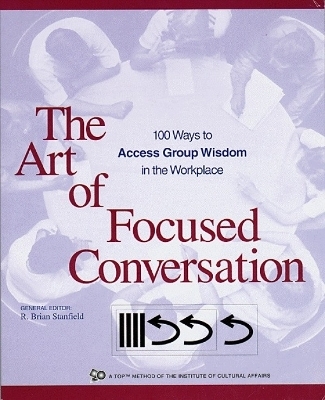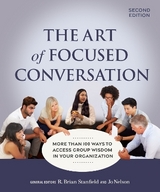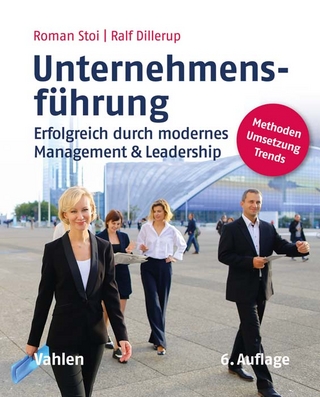
The Art of Focused Conversation
New Society Publishers (Verlag)
978-0-86571-416-8 (ISBN)
This book has served me so well in my new job. I can't tell you how many times I have pulled the book off the shelf to get some direction in creating my own questions. It has been a great asset in helping me have meaningful and directed conversations at a critical time in my new job. And it has saved me precious time. - Great book!?Marlene Lockwood, Group Leader, St. Helen's Hospital, Deer Park, California Communication within many organizations has been reduced to email, electronic file transfer, and hasty sound bytes at hurried meetings. More and more, people appear to have forgotten the value of wisdom gained by ordinary conversations. But, at different times in history, conversation has been regarded as an art form - a crucial component of human relations. Conversation has the power to solve a problem, heal a wound, generate commitment, bond a team, generate new options, or build a vision. Conversations can shift working patterns, build friendships, create focus and energy, cement resolve.
The Art of Focused Conversation convincingly restores this most human of attributes to prime place within businesses and organizations, and demonstrates what can be accomplished through the medium of focused conversation. The first Part describes the theory and background of the conversation method, which has been effectively used for group consensus making in: 1) problem solving; 2) troubleshooting; 3) coaching; 4) research and 5) interpretation of data. It also discusses how to prepare a conversation, how to lead a conversation, and what the common mistakes are. Part two then provides 100 sample conversations designed for use in many different situations, including: 1) reviewing and evaluating; 2) preparation and planning; 3) coaching, and mentoring; 4) data and media interpretation; 5) decision making; 6) managing and supervising; and 7) personal reflection and group celebrations. Developed, tested, and extensively used by professionals in the field of organizational development, The Art of Focused Conversation is an invaluable resource for all those working to improve communications in firms and organizations. "This book is absolutely fabulous.
I started it last night, used a whole bunch of stuff
Produced by the Institute for Cultural Affairs (ICA) in Canada, the book was edited by R Brian Stanfield, its Director of Publications. A non-profit with a presence in 48 countries, the ICA has worked for 45 years in organisational development, adult and child education, community development, and methods of social change.
Introduction: The Origin of a Method
Part I Theory and Practice Chapter 1. Why Conversations? And Why the Workplace?
The Fragmentation of Conversation
The image of conversation
Sound-bite conversations
Traditional Mental Habits
The culture of advocacy
Failure to understand each other
The possessors of absolute truth
The tyranny of the OR
The critics
The adversarial mode
Changes in the Workplace
The whole-system organization
The learning organization
Leaders as askers of questions
Beyond token participation
Methodology of real participation
Chapter 2. The Focused Conversation Method: An Overview
The focused conversation
A four-stage process
What if governments used the focused conversation
Public meetings
The workplace
No right or wrong answers
Advantages
Chapter 3. The Structure of the Focused Conversation
A natural process and a life method
Roots of the method
Life presuppositions
A whole-system process
The relationship arrows
Applying the method to structure a conversation
The objective level
The reflective level
The interpretive level
The decisional level
The aliases of the focused conversation
Chapter 4. Leading a Focused Conversation: Conversational Hazards
How to Lead One of the Conversations in this Book
1. Select a suitable setting
2. The invitation
3. Opening
4. The first question
5. Subsequent questions
6. Getting off the topic: what do you do?
7. Long or abstract answers: what do you do?
8. If an argument starts up: what do you do?
9. If people react to others' answers: what do you do?
10. Closing
Some Things to Keep in Mind
1. The leader has nothing to teach
2. The wisdom of the group
3. Abstract questions, abstract answers
4. The right group
5. Validity of the data
What about answers that are ethically or factually wrong?
6. Group ownership of the issue and content
7. Facilitator's responsibility
Chapter 5. Steps for Preparing a Conversation from Scratch
Preparatory Steps
1. Focus the conversation
2. Write down the intent of the conversation
3. Ensure a concrete beginning point for your objective questions
The power of focus
4. Brainstorm questions to realize the rational objective and experiential aim
5. Select the questions you need
6. Jiggle the order of the questions
7. Rehearse the conversation in your head
How many questions at each level?
8. Prepare your opening comments carefully
9. Prepare the closing carefully
10. Reflect on the conversation, the group, yourself
Why Didn't My Conversation Work? and What to Do about It.
1. Group isn't focusing
2. Group doesn't respond to questions
3. Group gives wrong answers
4. Group is not answering with real answers
5. Some participants dominate
6. Group goes off on tangents
7. Not getting useful results
8. Arguments break out
9. Group challenges the facilitator
Part II The 100 Conversations A. Conversations for Evaluating and Reviewing
A1. Reviewing the year
A2. Reviewing a workshop
A3. Reviewing a consultant's presentation
A4. Reviewing a planning event
A5. Reviewing the day
A6. Reviewing an organization's past
A7. Evaluating a seminar
A8. Evaluating a curriculum
A9. Evaluating the progress of a project
A10. Analysing a product that failed to sell
A11. Evaluating a marketing package
A12. Reviewing a major report
A13. Evaluating a staff service program
A14. Evaluating a trade show
A15. Evaluating a new business form
B. Conversations for Preparation and Planning
B1. Focusing a group before a workshop
B2. Introducing a new training topic
B3. Preparing a short presentation
B4. Getting input for a book review
B5. Preparing a group to write a report
B6. Preparing a symbol and slogan
B7. Planning a workplace study group
B8. Preparing the agenda for a meeting
B9. Organizing an in-house service group
B10. Planning a staff party
B11. Working on a brochure
B12. Assembling a budget
B13. Redesigning office space
B14. Envisioning new decor
B15. Selecting a topic for an upcoming conference
B16. Designing a customer service manual
B17. Initiating marketing planning
B18. Preparing a strategic presentation on a new product
C. Conversations for Coaching and Mentoring
C1. Coaching a colleague
C2. Talking through a job description
C3. Giving feedback to an instructor
C4. Holding accountability with an employee
C5. Discussing a set of employee guidelines
C6. Meditating on a difficult situation
C7. Mentoring a staff person in a family crisis affecting work #1
C8. Mentoring a staff person in a family crisis affecting work # 2
C9. Monitoring a new employee
C10. Resolving a longstanding misunderstanding
C11. Responding to a personal complaint
C12. Calming an upset customer
D. Conversations for Interpreting information
D1. Interpreting a story
D2. Sharing an essay
D3. Discussing a training video
D4. Holding a movie conversation
D5. Assessing social trends
D6. Holding a news conversation
D7. Pondering organizational change
D8. Appraising a sales offer
D9. Tailoring your services to a customer's needs
D10. Interpreting a systems audit
D11. Analysing budget performance
D12. Reflecting on a chaotic meeting
D13. Considering the impact of new regulations on a product
D14. Reflecting on a proposal for departmental reorganization
E. Decision-Making Conversations
E1. Helping a workmate think through a decision
E2. Making assignments within a team
E3. Deciding work priorities
E4. Discussing a staff response to a strategy document
E5. Breaking up a decisional logjam in a group
E6. Deciding on a trade show strategy
E7. Reframing a team's mission
E8. Implementing a new board policy
E9. Determining program priorities
E10. Developing terms of reference for a major project evaluation
E11. Building the annual budget
E12. Dealing with work environment issues
E13. Reworking office protocol
F. Managing and Supervising Conversations
F1. Canvassing employees
F2. Reviewing work descriptions
F3. Interviewing a job applicant
F4. Musing on a frustrating meeting
F5. Conducting a performance appraisal
F6. Assessing staff workplace needs
F7. Troubleshooting a stalled project
F8. Interpreting a shop floor grievance
F9. Naming market influences.
F10. Analysing sales statistics
F11. Dealing with delegation issues
F12. Collaborating on a supply problem
F13. Reflecting on a transition
F14. Highlighting the comparative profile of a firm
F15. Building a phased timeline for a restructuring project
F16. New managers' reflection on their leadership roles
F17. Assessing the impact of a training experience
F18. Creating participation guidelines
G. Personal and Celebrative Conversations
G1. Reflecting on the day
G2. Learning from a life event
G3. Planning for personal growth
G4. Facilitator's internal reflection while leading a group
G5. Appraising an additional assignment
G6. Celebrating a great victory
G7. Celebrating a colleague's retirement: a conversation with the individual
G8. Celebrating a colleague's retirement: group reflection
G9. Celebrating a staff birthday
G10. Interviewing the employee of the month
Part III Appendices A. Sets of Reflective and Interpretive Questions
B. The Bohm Dialogical Method
C. Power of the Conversation in Relation to Art
D. Prince 5 Weapons Story (to accompany Story-Telling Conversation)
E. Leading an Informal Conversation
F. Institute of Cultural Affairs International (ICAI)
G. Who Will Design These Conversations for Me?
H. Leading a Focused Conversation: A Summary
I. Preparing a Focused Conversation
Bibliography
Index
Charts and Sidebars
Relationship Arrows Diagram
Objective Level in a Nutshell
Reflective Level in a Nutshell
Interpretive Level in a Nutshell
Decisional Level in a Nutshell
What about answers that are ethically or factually wrong?
The Power of Focus
How many questions at each level?
Conversation Preparation Format
Why Didn't My Conversation Work
Preparing a Focused Conversation
| Verlagsort | Gabriola Island |
|---|---|
| Sprache | englisch |
| Maße | 184 x 229 mm |
| Gewicht | 435 g |
| Themenwelt | Wirtschaft ► Betriebswirtschaft / Management ► Unternehmensführung / Management |
| ISBN-10 | 0-86571-416-9 / 0865714169 |
| ISBN-13 | 978-0-86571-416-8 / 9780865714168 |
| Zustand | Neuware |
| Haben Sie eine Frage zum Produkt? |
aus dem Bereich



